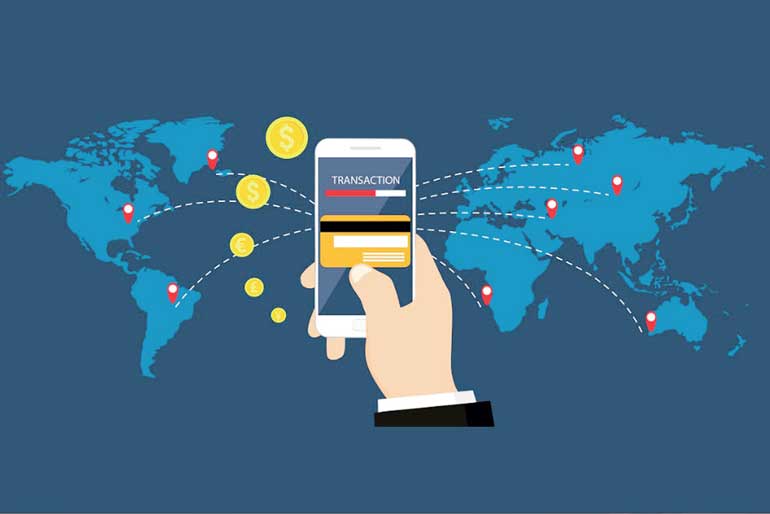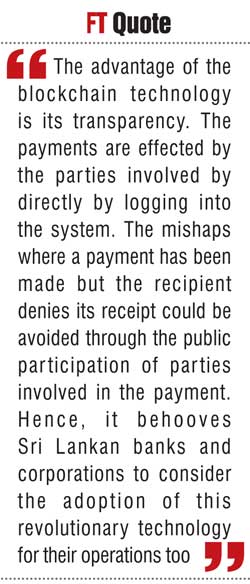Tuesday Jan 21, 2025
Tuesday Jan 21, 2025
Monday, 30 October 2017 00:10 - - {{hitsCtrl.values.hits}}

Blockchain has brought in a revolution in the use of the internet
Using online bank payment portals
Imagine a situation like this. You make an online payment to your internet service provider using your bank’s internet banking portal. You follow all the safety measures imposed by the bank like the first step password entry to your account, validating the transaction by using a second password and clicking all the relevant fields on the dialogue box.
The payment is instantaneous and you get a transaction number from the bank. You immediately get an SMS on  your mobile phone that your account has been debited by the said amount under the transaction number that had been issued by the bank’s internet banking section.
your mobile phone that your account has been debited by the said amount under the transaction number that had been issued by the bank’s internet banking section.
You are happy because you did not have to go to a payment centre or a bank to make the payment. It saved a lot of your time, inconvenience and hassle. Above all, you could make your payment in the middle of the night when the rest of the world is asleep.
A costly communication gap
But the following day, you find your internet router displaying a red icon indicating that it does not work. You call the service provider’s help centre to find that your internet is disconnected because you have not made the payments in time. You make a protest and insist that you made a payment the previous day. The agent at the call centre says that all what he could do is to register a complaint and he reads out a complaint number for future reference. You take it down and wait but your router still displays that red icon saying that it is not authorised to help you to access data.
In the evening, you call the help centre and another agent answers. His answer is the same and the payment has not been received. He politely advises that you should resolve it with the bank. You now get agitated because you had no internet for one day and it seems that you are to go without internet for another day too. You call your bank’s online payments help desk but no one answers; apparently, they all have closed the shop for the day.
A high-tech firm taking ages to reconcile accounts
You call the bank manager and she is still at the bank though it is late in the evening. She promises to look into the matter and report back the following day. Given the circumstances, there is no choice for you but to wait and live another day without internet.
The following day, it is revealed that the bank has done the transfer correctly, but it has gone into a different service account and therefore had remained as unsettled. The service provider, though he says that he ‘brings future to its customers today’, takes at least 24 hours to reconcile the accounts. For a large high-tech company, it seems somewhat an odd practice.
Delays in completing transactions are costly
This was exactly what happened to this writer last week. The problem was solved in three days. But in the modern world driven by advanced information and communication technology or ICT, three days are like three years. Both the banking industry and the telecommunication industry rely heavily on modern technology. Hence, they should have facilities to process and complete transactions instantaneously. If something goes wrong, it should be resolved within three minutes and not within three days.
An issue involving governance of large corporations
This issue poses several questions about the governance structure in large corporations, the gap between what they publicly promise and what they deliver, the use of outdated technology and poor customer care, though he is the source of their income and thus the guarantee for existence.
Banking transactions kept in secrecy from customers
There is a salient feature in modern day banking transactions. That is, they keep the customer completely in the dark during the entire process. Once a customer gives instructions to a bank, it opens its systems to fulfil his desire. Yet, all the systems within the bank are kept closed to the customer. He would come to know about its success or failure only after everything has happened. 
This is better than the era of the physical mail – now known as ‘snail mail’ – during which all communications to customers about the success or failure were sent with a time lag of about two weeks depending on the speed of the physical mail in his country. But today, all communications should take place instantaneously on a real-time basis. If customers have to wait two weeks at worst or two days at best to know the outcome of his banking transactions, the likelihood is that things can go wrong beyond the point of recoverability.
Imagine a bank customer using online banking services to pay someone and his message is intercepted by a hacker who directs it to somewhere else. The customer would know of it only when the other party complains about the non-receipt of the payment.
Satoshi Nakamoto’s solution
To resolve this issue, in 2008, an anonymous computer nerd or a group of nerds working under the pseudonym Satoshi Nakamoto came up with a proposal for a peer to peer digital payment system bypassing the banking system.
The paper titled ‘A peer to peer electronic cash system’ (available at: https://bitcoin.org/bitcoin.pdf) provided the blueprint of producing a digital currency now known as Bitcoin and its operational mechanism called the blockchain. The blockchain is a public ledger that can be used by many to update and view transactions – a feature which qualifies it to be called a distributed ledger.
Blocks of transactions organised as chains to build a blockchain
Transactions are grouped into blocks and timestamped so that the verification of the payment becomes easy, double payment prevented through timestamping, peers are organised as networks avoiding third party intervention, and facilities are provided to combine or split payments.
An electronic coin, according to Nakamoto, is a chain of digital signatures. Each owner possesses two keys, a public key that can be seen by others and a private key known only to him, generated by the computer system. Coins are transferred by the present owner to another by signing a hash – an authentication that it is a genuine transfer from the previous owner – and the public key of the next owner, while simultaneously authorising the transfer by signing his private key.
Bitcoins are stores in a digital wallet and the use of the public key and private key will enable the new owner to open his wallet and release the coins stored therein. Thus, there is a chain of all the transfers made and they are all connected through a node – a point at which two digital signatures meet. The new owner can verify the authenticity of the transfer by looking into the public keys of all the previous transfers.
Involvement of many people in completing a transaction
Blockchain is a distributed network where all parties will participate in the process simultaneously. There is no need for one person to complete his work for another to begin. How a distributed ledger works has been explained by William Mougayar by comparing it to a Google Doc and contrasting it from the traditional Microsoft Word document.
The present way of group editing a document is to produce it first as Word document, send it to each party as an attachment through email and get them to open, edit and send back to originator of the document. Till it is sent back, no party in the group can know what the other party is doing to the document and how he is editing it. There is not only a time lag, but also a dark cloud of ignorance separating them from each other. This is how banks at present complete transactions with two customers.
Suppose customer A wants his bank to deduct a certain amount of money from his account and pay to customer B. The bank after receiving the instructions blocks both accounts to the parties concerned. It deducts money from A and pays B and opens the system for the two customers after the whole transaction has been accomplished. Until the bank opens the system, both customers are in the dark and do not know what is happening to their transaction. Any inquiry from the banker would be responded by a ‘work in progress message’.
Everyone knows everything
All transactions in blockchain are publicly announced and therefore, all those operating in the chain are privy to that information. It thus takes away from customers the veil of privacy which is provided to them by the traditional banking system. This is a weakness of the blockchain.
To resolve the issue, Nakamoto suggests that the public key through which the transaction is publicly announced should be kept anonymous. In that way, though the public can see that someone is sending money to another, without knowing the identity of the parties, they cannot point it to anyone. In the stock exchanges, similar practice is followed. Accordingly, though the stock exchange releases the data on the value and the quantity of a trade, it does not release the identity of the transacters.

Nakamoto says that this anonymity could be strengthened by having a system where transacters could have different blocks for different transactions. Therefore, for each block, there would be separate public and private keys. Since the public keys through which the announcements are made are different, it is difficult to trace a transaction to any particular party or a group of parties.
The blockchain revolution
Blockchain has brought in a revolution in the use of the internet. Hence, sometimes it is referred to as the Website 3.0 where there is connectivity with a number of parties and forward and backward interaction with them. A number of business applications have been developed by using the blockchain, according to website BlockGeeks.
a) Introduction of smart contracts in which performance criteria are coded through distributed ledgers so that delivery of obligations could be linked to the satisfaction of designated requirements.
b) Blockchain can promote peer to peer transactions so that the intervention of a third party could be eliminated, thereby establishing a true sharing economy.
c) It can also increase crowd funding by enlisting the support of many parties at a relatively low cost and enhanced convenience.
d) Blockchain is fully transparent and publicly available so that it could improve the governance of society and could be used in elections or public polls.
e) Supply chain auditing, a must for ensuring quality and timely delivery, could be introduced through transparent distributed ledgers.
f) Safety of file storage can be assured by distributing the data to many points in a network making it less remunerative for hackers to hack.
g) By digitising personal documents and information, distributed ledgers can help better identity management.
Online transfer of value
Blockchain is a revolution in the application of internet today. While internet transfers information, blockchain transfers value (see: https://www.youtube.com/watch?v=Pl8OlkkwRpc). Hence, it is sometimes referred to as internet of value. When someone sends an attachment like a document or power point presentation via email, he sends only a copy. The original is still retained by the sender. However, in the case of the blockchain, it is the real things that are transferred.
For instance, if someone makes a digital currency payment, he uses the original and not a copy to make the payment. When the originals are paid via the blockchain, there is the possibility of hackers intercepting them in the cyberspace and changing the direction of payment to someone else. The blockchain has introduced safety measures to prevent such midway hacking. Those safety measures have been successful in limiting the incidence of hacking virtually to a zero level.
Promise of making a giant one day
So far, the use of Bitcoin or the associated blockchain has been a drop in the ocean. As at end of September 2017, the total number of Bitcoins issued had been only 16.6 million with a value of less than $ 100 billion as against a global GDP of more than $ 80 trillion. But, as a regulatory, accounting and auditing system, it demonstrates a compelling promise for the future.
The regulatory function performed by the blockchain is assured by its coding system. The compliance is met through the network that rejects any unauthorised instruction for payment. Even a restrictive monetary policy has been built into the master of the blockchain, Bitcoin, by limiting its supply; the computer programme that governs the issue of Bitcoins does not allow oversupply.
Excessive bureaucratic control of present payment system
The present financial system is a centralised operation and all centralised operations are subject to risks on account of the excessive bureaucratic controls they have introduced. However, the blockchain is a decentralised operation. Hence, it commands superiority over financial institutions.
The flexibility which the blockchain enjoys and the speed at which it could process and effect payments are some features demanded by customers. If banks do not take any action to meet them, it is inevitable that banking customers would move to systems that can satisfy their desires. In this sense, the blockchain will be a killer App for banks.
Many following Bitcoin and the blockchain
Now there are proposals to use the blockchain technology to deliver government services to citizens under an App called ‘govchain’.
With the threat of digital currencies posing to central banks, Bank of England and the Bank of Sweden have announced that they are seriously considering the issue of their own digital currencies in the future. The major banks like the Citibank and the Bank of America are experimenting with their own digital currencies. The IMF too, according to its Managing Director, Christine Lagarde, is considering the issue of its own digicoin. All these systems will use the blockchain technology as the operational platform.
Bank customers need not be in the dark
The advantage of the blockchain technology is its transparency. The payments are effected by the parties involved by directly by logging into the system. The mishaps where a payment has been made but the recipient denies its receipt could be avoided through the public participation of parties involved in the payment.
Hence, it behooves Sri Lankan banks and corporations to consider the adoption of this revolutionary technology for their operations too.
(W.A. Wijewardena, a former Deputy Governor of the Central Bank of Sri Lanka, could be reached at [email protected].)